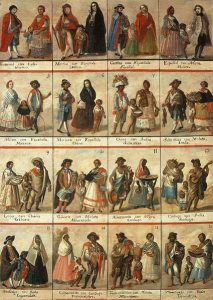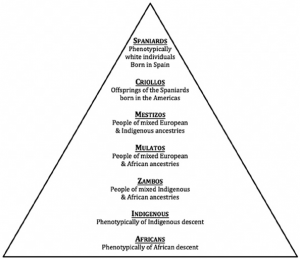
Las castas. Anonymous, 18th century, oil on canvas, 148×104 cm, Museo Nacional del Virreinato, Tepotzotlán, Mexico.
From the late 15th century onward, three significant cultural entities met on the American continent, each comprised of numerous subcultures, some sovereign in their own right. The Indigenous peoples of the continent, the Spanish, Portuguese, and other Europeans, and the Africans of many nations transformed the future population and civilization of the “New World” through their encounters. Relations, whether consenting or forced, engendered what some call mixed-race people who came to inhabit Latin America, which, up until the middle of the 19th century included much of the Southwestern U.S.
The blended identity is a product of Spanish policies toward Indigenous peoples encountered on their mission of resource acquisition and domination. In contrast to the U.S. policy which focused on policies of forced removal, relocating communities to other regions or reserved lands, the Spanish systems of the encomienda and corregimiento were mechanisms by which to increase the labor force by bringing Indigenous peoples into society, such as in the Missions of California.
Not all Africans who arrived in the New World were brought under duress. Afrodescendant Spanish conquistadores participated in the conquest project. However, over time, the association of Black Africans with enslavement created a subaltern class based on phenotype. Spaniards who asserted that they had arrived from Spain and/or remained “pure” blooded (lacking African or Indigenous parentage in their ancestry), used this status to control everyone else in the colonies. An elaborate system of social stratification based on skin-color and phenotypical characteristics reinforced the political, economic and social power structure that kept the Spaniards at the top even as the indigenous and African groups were exploited.
Placement within the system determined access to education, titles and other rights. Several strategies were imposed to create greater separation among the races including segregating neighborhoods and applying dress codes. In the play, we see Doña Amador and Sra. Lasuén both object to the servants wearing their masters’ garments. A new genre of art-work, which later came to be call casta paintings (above), popularly delineated the nomenclature of racial heritage.
Another categorization made by Spaniards in the New World reflected their investment in the project of converting the Indigenous people, who were often perceived as naïve, childlike, and ready subjects for Christianity. Spaniards and Africans (because of their acculturation to Spanish culture) were known as gente de razón, or people of reason, a distinction made by Sra. Lasuén in the play. Indigenous people, such as Francisca, the neophyte child in the play, were known as gente sin razón, people without reason.
In the encounters with the Indigenous inhabitants of Alta California, the Spanish settlers (including their acculturated casta servants) united in a self-identification as one people, gente de razón. The gente sin razón, the Indigenous that the Spanish intended to conquer, were placed at the bottom of the hierarchical system of rights and privileges. As Spain constructed its new presidios (forts), missions, and towns, some Indigenous resisted or simply left the territories, others entered the new constructions for safety, as servants and neophytes/students of the conquering society. There is a similarity of purpose with this Spanish project of indoctrination and the residential schools of the United States and Canada.
Sources cited:
Chavez-Dueñas, N. Y., H. Y. Adames, and K. C. Organista. “Skin-Color Prejudice and Within-Group Racial Discrimination: Historical and Current Impact on Latino/a Populations.” Hispanic Journal of Behavioral Sciences 36.1 (2014): 3-26
“Las Castas – Spanish Racial Classifications.” Native Heritage Project: Documenting the Ancestors, 15 June 2013, nativeheritageproject.com/2013/06/15/las-castas-spanish-racial-classifications/
Live Science Staff. “Africans Came with Columbus to New World.” LiveScience, Purch, 20 Mar. 2009, www.livescience.com/3423-africans-columbus-world.html
Restall, Matthew. Seven Myths of the Spanish Conquest. Oxford University Press, 2004.
Restall, Matthew, and Kris E. Lane. Latin America in colonial times. Cambridge University Press, 2011.
